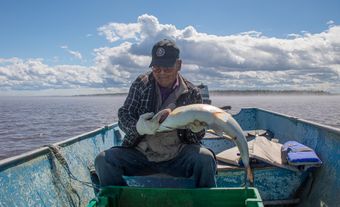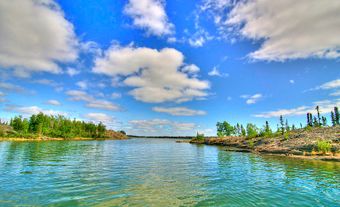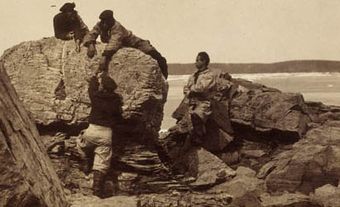Yellowknife, Northwest Territories, incorporated as a city in 1970, population 20,340 (2021 census), 19,569 (2016 census). The city of Yellowknife is the capital of the Northwest Territories and the territory's only city. It sits on the Canadian Shield, on the north shore of Great Slave Lake, and about 400 km south of the Arctic Circle. Due to its northerly location, Yellowknife is the Canadian city with the most hours of summer sunshine, averaging 1,030 hours per year. The city and Yellowknife Bay were named after the Yellowknives, a Dene band who lived on the islands of Great Slave's East Arm and travelled as far north as the Arctic coast to obtain copper for knives and other implements. They, in turn, acquired their name from the copper-bladed knives they carried.
Indigenous Peoples
Yellowknife is situated in the territory of the Tlicho (Dogrib), a Dene people who historically occupied the land between Great Slave Lake and Great Bear Lake. The Tlicho were nomadic and relied on caribou as a source of food as well as material for clothing, shelter and tools. Although the Tlicho typically lived in small societies, they often gathered in larger groups for the spring and fall caribou hunt.
European Settlement
Peter Pond, a North West Company fur trader, was, as far as is known, the first non-Indigenous person to reach Yellowknife, possibly in 1785 and almost certainly two years later. Yellowknife Bay appears on a map he produced in 1785, but there is no surviving record of his travels in that year, and he may have drawn that portion of his map from information provided by Dene trappers. He did establish a post named Fort Providence, 30 km southeast of the present city, in 1786. Fort Providence operated as an outpost camp for Fort Chipewyan (1778), on Lake Athasbasca in what is now northern Alberta, until 1823. (Present-day Fort Providence, on the Mackenzie River, was built in 1869.)
Sir Alexander Mackenzie visited Old Fort Providence in 1789, en route north in search of the river that bears his name, and Sir John Franklin followed in 1820, camping near the site of the present-day city on his way to the Arctic coast. However, aside from an occasional hunter, trapper or prospector who camped in the well-sheltered bay, the area had few other visitors. Dettah, a tiny Yellowknife Dene community 12 km southeast, was the only settlement in the area.
The arrival of Europeans in the region brought diseases which severely affected the Indigenous population. In addition, fur traders introduced European-manufactured goods to Indigenous communities which altered their traditional patterns of life. For example, firearms and fishnets transformed hunting and fishing from a group activity to an individual one. (See also Treaty 8; Treaty 11; Reserves in the Northwest Territories.)
Development

Gold was first found near Yellowknife in 1898 by a prospector heading for the Klondike Gold Rush in the Yukon. The first free (i.e., visible) gold was not discovered until 1934. That triggered a claim-staking rush which transformed a lonely bay into a frantic, overnight boomtown of shacks, tents and dugouts.
Yellowknife's first successful gold mine, the Con Mine, went into production in 1938. Prior to the discovery of gold, the economy of the Yellowknife region was based on the fur trade. The opening of the Con Mine, however, began a boom which led to five more mines opening in the next 15 years. Mining supplanted the fur trade as the driving force of the economy, and by 1940 Yellowknife had a population of about 1,000. Although they were central to the fur trade, few Indigenous peoples found work in the mining industry.
Manpower demands of the Second World War shut down all mining operations except the Con Mine, but development resumed at the war's end. In 1948, the Giant gold mine became the second producing mine within the city limits. Workings of the huge Con Mine, 1,860 m deep, extended under most of the city and Yellowknife Bay almost to the community of Dettah. In the words of local composer Robin Beaumont, for over 60 years Yellowknife was "a city where the gold is paved with streets."
In 1986, the Giant Mine became one of fewer than a dozen gold mines in the world to produce 10,000 gold bricks. The Giant Mine was also the scene of what has been described as one of the bloodiest disputes in Canadian labour history. In September 1992, after the mine owners brought in replacement workers during a strike over stalled contract negotiations, a striking miner murdered nine men, six of them strikers who had crossed the picket line, when a bomb he set blew up the man-car they were riding, 225 m underground. Due to depleted reserves and high costs the Con Mine closed in 2003, and the Giant Mine closed the following year.
Cityscape

Yellowknife’s high-rises are by-products of the development-boom in the 1970s after the city was named the capital of the Northwest Territories in 1967, making it the centre of government and administration. The skyline features a number of high-rises. The Centre Square condominium, at 20-storeys, is the tallest, followed by two commercial properties, the Scotia Centre and Precambrian Building, each at 11-storeys. Much of the city’s original architecture, featuring pioneer shacks and cabins, still exists alongside modern development. One of the challenges the city faces, along with other communities in northern Canada, is the cost of living. Housing can be prohibitively expensive. In 2020, for example, the average rent for a two-bedroom apartment in Yellowknife was over $1,700, making it one of the most expensive rental markets in the country. For comparison, during the same year, the average rent for a two bedroom apartment in Vancouver and Toronto, two of the costliest cities in Canada, was over $1,800 and $1,600 respectively.
Population
Nearly 50 per cent of the Northwest Territories’ population lives in Yellowknife. Just over 76 per cent of these residents identify as either Canadian, English, Scottish, Irish or French, according to the 2021 census. Indigenous peoples make up a further 24 per cent of people living in the city. Other relatively large ethnic groups include Filipino (6.9 per cent of the population), Black (4.4 per cent) and South Asian people (3.1 per cent). Common countries of origin for immigrants living in Yellowknife are the Philippines, India, the United Kingdom, Viet Nam and the United States.
Economy and Labour Force
Historically, the gold mining industry and government administration were the largest employers in Yellowknife. Although many government employees were transferred to the newly created territory of Nunavut in 1999, the majority of Yellowknife’s population continues to be employed in the public sector, with the Government of the Northwest Territories being the city’s single largest employer. By 2004, the last gold mine in Yellowknife had closed, but Canada's first diamond mines opened northeast of the city (Ekati in 1998, Diavik in 2003 and Snap Lake in 2008). The diamond mines have also brought secondary industries such as diamond polishing plants, and a diamond sorting and valuation facility. The city has trademarked the slogan, “Diamond Capital of North America.” Yellowknife is also the staging area for the exploration of base metals as well as oil and natural gas.
Tourism is an increasingly important sector of the economy with outdoor recreation (e.g., wildlife viewing, fishing, canoeing, hiking), the midnight sun during the summer, the Northern Lights in the winter and Indigenous cultural events acting as tourist draws. In addition to government administration, Yellowknife is also the transportation and communications hub of the territory.
The city’s remote location, specialized industries and high cost of living have resulted in a shortage of skilled labour. Although the average household income in Yellowknife is double the national average, Yellowknife households also spend 50 per cent more than the average Canadian home.
Transportation

Until 1960, Yellowknife was only accessible from the south by air, water and winter tractor train from Hay River, on the south shore of Great Slave Lake. The Yellowknife Highway, with a ferry across the Mackenzie River at Fort Providence, opened in that year. The Fort Providence ferry kept a channel open until an ice bridge could be established farther upstream. Goods were shipped in from the south by air during spring ice break-up on the Mackenzie River, which could take up to three to six weeks. On 30 November 2012, the permanent cable-stayed Deh Cho Bridge was completed and replaced the previous ferry/ice bridge methods.
Canadian Pacific Airlines (CPAL) constructed the Yellowknife Airport in 1944. The Department of Transport took over from CPAL in 1946 and added two new gravel runways to the original single strip. During this initial period, Northern Flights Limited and CPAL were the only carriers. As the hub of the territory, increased air traffic necessitated the building of a modern facility. A new terminal was constructed in 1963 and a new control tower added in 1972. The facility has undergone several phases of expansion and a major renovation was completed in 2006.
Like air transport, trucking is a major Yellowknife industry. Winter roads, mostly over frozen lakes and rivers, fan out from Yellowknife after freeze-up and serve isolated mines like the Lupin gold mine and diamond fields in the Lac de Gras area. Yellowknife Transit operates the city’s local bus service.
Communications
Northern News Services publishes two local newspapers, the Yellowknifer and News/North. A French-language paper, L’Aquilon, is also published in Yellowknife. Several radio stations serve the Yellowknife area. Television is offered by CBC North, and cable television via satellite. The nationally-distributed Up Here magazine is published in Yellowknife, as well.
Government and Politics
Yellowknife was first incorporated as a municipal district in 1953 and elected its first mayor, John G. McNiven, that year. In 1967, Yellowknife was named capital of the Northwest Territories when the federal government transferred some administrative control to the territory. The commissioner of the Northwest Territories and territorial government offices, who until that time were in Ottawa, were then moved north. Three years later, Yellowknife was incorporated as the Northwest Territories' first and only city.
The Legislative Assembly building in Yellowknife is one of the newest legislatures in Canada. City Council is served by the mayor and eight councillors elected for four-year terms. Council is responsible for planning and zoning, land development, property taxes, transportation, parks and recreation, water and sewage as well as garbage disposal.
Cultural Life

The log-built Wildcat Café was built in 1937–38, by pioneers William Wiley and Smokey Stout, and designated a heritage site in 1992. As one of the earliest buildings in the city, the Wildcat is a well-preserved example of early rustic architecture. The café served as a meeting point for prospectors, miners, pilots as well as residents until its initial closure in 1951. Yellowknife is also home to “Ragged Ass Road,” so-named by three locals, who put up a hand-painted sign after a night of drinking to describe the shanties in the area. It provided the inspiration for a Tom Cochrane album of the same name. The neighbourhood in which both these sites are located is called Old Town, and was where miners and prospectors first established themselves in the 1930s.
Yellowknife has nine additional heritage sites including the Canadian Pacific Float Base, Weaver and Devore Store (Yellowknife’s oldest trading post), Hudson Bay Warehouse, Back Bay Cemetery, Fireweed Studio, Old Log School House, Bank of Toronto Building, Yellowknife Post Office, and Bristol Freighter.
Yellowknife's Prince of Wales Northern Heritage Centre serves as the museum and archives for the territory. The Northern Frontier Visitors’ Centre features exhibits on Yellowknife’s history, mining and geology, Indigenous culture and natural history. The Northern Arts and Cultural Centre is a theatre facility hosting local drama companies and visiting artists.
As a city nestled in the wilderness, Yellowknife plays host to a number of outdoor activities and festivals throughout the year, including the Dog Island Film Festival and the Diavik 150 Canadian Dog Championship Dog Derby. Visitors can explore a number of hiking trails and waterfalls, ice fish and dog sled, as well as take in the magnificent aurora borealis.

 Share on Facebook
Share on Facebook Share on X
Share on X Share by Email
Share by Email Share on Google Classroom
Share on Google Classroom




